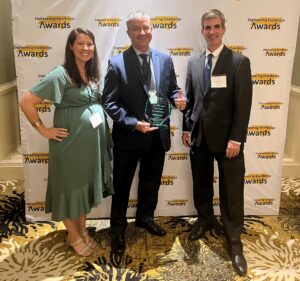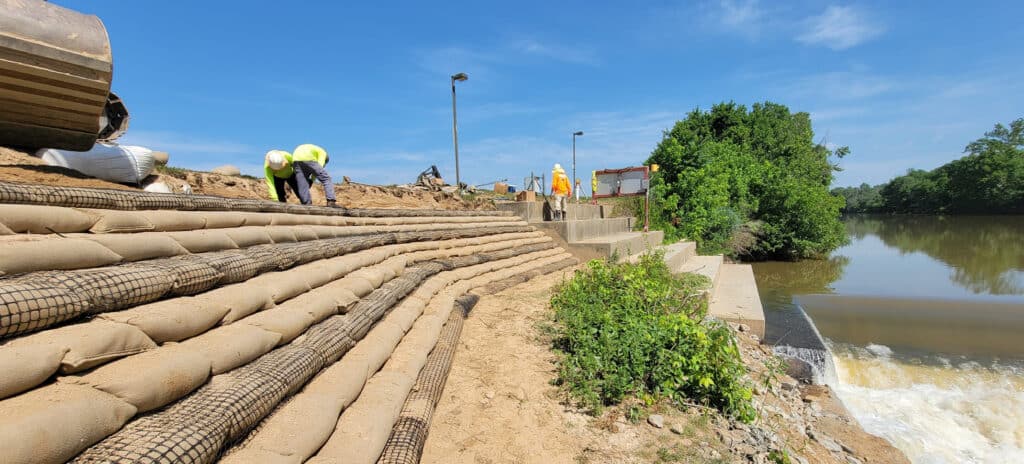Innovative Bioengineering Stabilizes Riverbank and Protects Winston-Salem’s Water Supply

This innovative project received an Honor Award in the ACEC North Carolina 2023 Engineering Excellence Awards competition.
In Winston-Salem, North Carolina, critical erosion issues along the Yadkin River posed risks to public safety and essential water services. The Swann Intake Erosion Repair project used bioengineering to stabilize the bank effectively and protect the city’s water intake within budget constraints. This innovative solution not only preserved the dam’s integrity but also ensured the continuation of vital services to the community, demonstrating a practical application of sustainable engineering.

Erosion over time became magnified and noticeable by the City of Winston-Salem when low-head dam warning signs that ensured public notification of the dam downstream needed replacement at several locations along the riverbank. Further downstream of the dam, the intake side of the river was eroding rapidly. Damage along the riverbank amounted to substantial erosion and failure of the gabions at the dam abutment, leaving the dam intake in imminent danger of damage and significant disruptions to critical services in the City. The Swann Intake Erosion Repair project needed to not only replace life-saving dam warning signs but also provide riverbank stabilization, protect the intake to preserve water service and utilize a project design that would reduce material costs to stay within the original capital improvement project (CIP) budget.
After receiving a call from the City, Freese and Nichols’s (FNI) first step was an initial evaluation of the existing site conditions, which ultimately resulted in several site visits and the inclusion of a geomorphic assessment to fully understand the erosion occurring at the site. Upon inspection of the site, FNI determined the City’s needs differed significantly from the original scope of work when the CIP and budget were first created. There were two separate challenges to the Swann Intake low-head dam project. The erosion of 150 feet of riverbank had undermined the Federal Energy Regulatory Commission (FERC)-required upriver warning signs for boating traffic to prepare to portage around the dam. Then, further downstream at the dam site, the west bank had failing rock gabions along the abutment, and the east bank had erosion around the intake. These imminent failures threatened the long-term function and stability of the low-head dam and intake.
The gabions needed immediate repair to stabilize the riverbank and save the City further costs and service disruption and the river “cutting around” the dam. This was especially challenging with the limitation of the set budget, but even more so due to the more significant problem of not removing the existing failing gabions due to concerns of dam instability during construction.
Streambank Stabilization Approach
FNI provided design services for the Swann Intake Erosion Repair project, which involved repairing a section of the riverbank using bioengineering techniques. This design improves the existing dam and stability, is cost-effective, and the bioengineered system promotes resiliency and self-repair. FNI retained the existing infrastructure by protecting it and utilizing a green solution. A geobag wall system was placed above a structural stone veneer, which was installed around the gabions so that as gabions corrode and fail, they are encased. The intake side of the dam was stabilized primarily by reconfiguring the large habitat stones just off the east bank so that the flows were redirected away from the bank. In just a year, a bank that was eroding now has sediment depositing on it as a result of the very economical solution to change the flow geometry while using onsite materials.
The upriver warning signs for in-river traffic were determined to have a practical relocation solution. The low-head dam warning signs needed to be moved back and enlarged to ensure they would be visible to boat traffic before reaching the dam downstream. FNI determined the best solution was a long-term approach, which involved raising enlarged warning signs onto poles and moving them back from the riverbank, coupled with the maintenance of riverbank vegetation to maintain the visibility of warning signs.
The overall project approach served as an effective technique to identify site conditions, determine improvement options, and select the most effective repair technique to help the City with long-term bank stabilization. The team utilized a combination of assessment data and constructability review to design and stabilize the existing gabions for a successful proposed solution – bioengineered riverbanks above the terminal height of the gabions to protect the gabions and dam from the continued erosion of the upper portion of the riverbanks. The solution also provided long-term stability to this dynamic location along the riverbanks.
FNI’s approach displays that bioengineering approaches can be used in complex hydraulic situations, favoring sustainable, environmentally friendly approaches as stabilization solutions. The completed project is an example of how blending solutions (stone and vegetation) can create a balanced design to protect the engineered system while promoting the function of the natural system.

Measurable/Sustainable Results
The City’s original CIP budget was met, which was never intended for this complexity of work. The initial scope included three locations of bank repair for signage totaling about 150 feet. Initially, the scope did not involve the constraints of nearby infrastructure by detecting the severity of the riverbank erosion, and the City’s needs differed significantly from what they initially anticipated. The natural materials used as engineering measures show the ability to provide feasible options outside of traditional manufactured materials. This approach displays an excellent example of how sustainable materials and methods can achieve the same or better results.
FNI provided the City with significant cost savings by avoiding future infrastructure repairs that would be more costly. By designing a solution to rework and reuse the existing stone in the river and along the banks in a manner that used river physics to protect the intake side of the river from continued erosion, the City was able to save costs and remain within budget. The project also included permitting and delineation for Waters of the US (WOTUS).